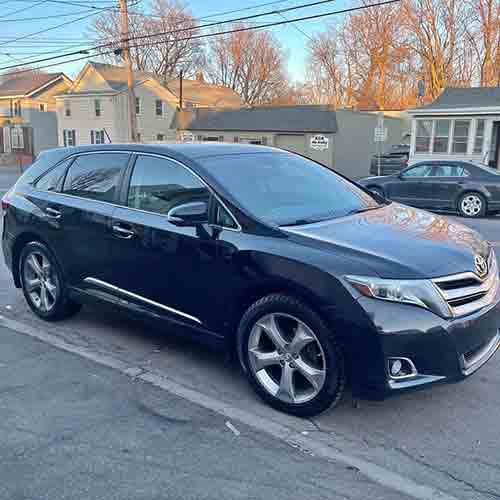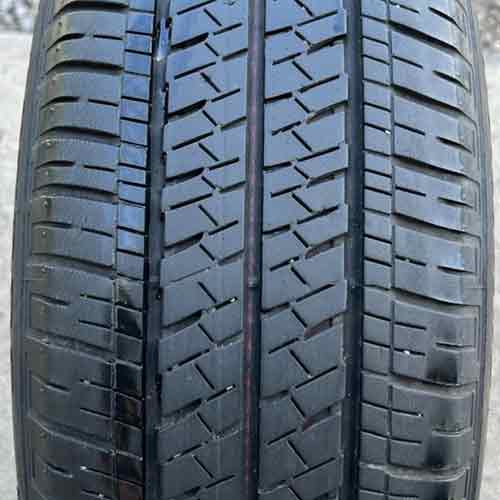The Bridgestone Ecopia and the Yokohama BluEarth are two strong fuel efficient contenders. These tires are ideal for eco-conscious drivers looking to reduce their carbon footprint. But which tire is a better fit for you? Well let’s find out.

As a tire engineer, I can tell you that the Yokohama BluEarth tires excel in hydroplaning resistance and tread life due to a more voided tread design and harder compound, while the Ecopia series offers better wet grip and braking distances because of its interlocking sipes and densely packed lugs. Though take note that the Ecopia tires have a shorter tread life on average, as they generate greater rolling resistance values.
Table of Contents
Wet Traction
The wet performance of a tire is predominantly influenced by two key elements: hydroplaning resistance and wet grip.
That’s why I talked about them both separately below.
Wet Grip
Wet grip is highly dependent on the sipes. That’s why with relatively fewer sipes, the Yokohama BluEarth series is somewhat lacking in this area.
Sipes are small slits in the tread that act like water vacuums, absorbing water particles, so that the tread can maintain contact with the surface.
These slits basically expand and contract, creating vacuum, which sucks up water particles. And that’s the reason why tread flexibility is also a factor here, because the more pliable the tread, the more easily sipes are able to create suction.
The Bridgestone Ecopia tires on the other hand, provide you with a combination of full-depth interlocking sipes and in groove notches and both of these work together to provide better braking distance values, and handling (lap) times (on average).
Basically while the sipes clear off water, the biters/in-groove notches are able to grab the relatively dried up surface in a better way.
Hydroplaning

While the Yokohama BluEarth series may not excel in wet gripping and handling, it performs remarkably well in resisting hydroplaning.
And its superior performance can be explained by its more voided up tread design. Meaning these tires predominately offer wider pathways for the water to leave out quicker.
On the other hand, the Ecopia series faces slight challenges here due to its relatively narrower longitudinal ribs, on average.
I mean, if you consider all these tires, you’d note that mostly all of them have more closed up pattern, especially towards the shoulders, so they don’t allow as efficient water removal, especially sideways.
And so you end up with smaller float speeds, as seen in both curved and straight aqua tests.
Side Note: Float speed is simply the speed of the tire with which it rolls over the water-filled surface.
Rolling Resistance
Like the fuel economy, rolling resistance also affects tread wear.
Now here, the Ecopia series with slightly higher rolling resistance values, ends up with shorter tread life relatively.
On average, these tires have a heavier load, and that basically puts more pressure on the lugs as they rub against the road with greater friction. And needless to say, that accelerates rubber wear.
Moreover, these tires also have smaller tread depth, on average, and this also contributes a lot. As with more tread depth, it would take more time to reach down to the 2/32″ replacement level.
Conversely, the Yokohama BluEarth tires are made of a more durable and harder compound, making them less susceptible to rapid wear.
Additionally, these tires have wider internal steel belts, a jointless full-cover reinforcement ply, and folded belt-edge tape. And all of these also contribute to their increased reliability and enhanced puncture resistance, indirectly adding to the overall tread life.
Dry Traction
Dry traction is divided into two categories: grip and handling.
The grip is usually assessed by measuring braking distances, while handling is evaluated by analyzing lap times.
Now here, although both tire series do okay, I would still go with Ecopia tires.
This is because these tires come with more densely packed lugs, especially in the central area, so they make a firmer connection with the road as they roll straight.
Basically as the tire moves in a straight line, most of the weight is concentrated towards the middle, and Ecopia tires forming better rubber to road contact form there gets to offer superior braking distance values.
On the other side, the Ecopia series excels in handling, where it lacks in directional gripping. These tires basically offer better cornering stability and a more responsive steering.
This can be attributed to their tires having a lighter weight, and interconnected shoulder blocks, which offer a greater contact patch.
As the tire corners, shoulders get the most weight pressure on them, and with better road connectivity, Ecopia tires get to offer greater lateral g forces on average.
Tread Life

The lifespan of tire’s tread is primarily dependent on three key factors.
- Rolling resistance.
- Tread depth.
- Rubber composition.
Rolling resistance is self explanatory, but for other two, let me explain. Generally, tires with a deeper tread depth would take more time to wear down to replacement levels. And if tires have a stiffer rubber on top, they would resist wearing off quickly.
Having said that, across all models, it can be seen why the Yokohama BluEarth series is the preferable choice in this regard.
These tires on average have greater tread depth, and their tread compound is made out of stiffer materials, which effectively resist rapid tread degradation.
On-Road Comfort
Comfort in a tire largely depends on two factors: noise reduction and impact absorption ability, and considering both tires series, you get mixed results here.
I mean the Yokohama BluEarth series excels in reducing noise levels, whereas the Bridgestone Ecopia series offers superior, what they call, impact comfort performance.
Let’s start with noise.
So noise is essentially caused by air particles colliding with the tire’s tread walls. So this means with more voided up design, a tire would be louder.
That’s why with compacted up desings the Yokohama BluEarth series is taking the upper hand.
Moreover, these tires also incorporate a more advanced pitch sequencing technology, which angles its lugs in such a way that air particles generate different frequencies in different areas (when they collide).
(These diverse frequencies then cancel each other out, resulting in lower noise levels).
On the other hand, while the Bridgestone Ecopia series also incorporates decent pitch sequencing, its tires’ softer rubber compound tends to produce greater in-groove resonance, which is a fancy term for the echoing of sound waves.
Simply put, the tire’s tread reflects more noise.
But then again the softer compound (on average), of these tires also help in absorbing road vibrations effectively. So bumps are soaks up before they reach the drivers seat.
Fuel Consumption
The effectiveness of fuel consumption is significantly affected by the rolling resistance, which is determined by some tire characteristics, such as tread composition/structure and weight.
Now comparing both tire series, you get to note that they are both doing okay here.
However, a side-by-side comparison reveals that the Bridgestone Ecopia series is still the better option here relatively.
But why?
Well, the Bridgestone tires are not only lighter than Yokohama BluEarth tires but also have a harder rubber composition that reduces surface adhesion, facilitating smoother rolling and consequently lower fuel consumption.
On the other side, the softer compound of the Yokohama BluEarth tires leads to more lug bending on average, resulting in energy loss.
This is because the fuel energy is consumed in molding the tread rather than in the actual rolling of the tire.
Winter Performance
Evaluating a tire’s winter performance reveals some very interesting results.
Upon examination, it was found that the Ecopia series lags slightly in this area. This is because on snow, you need biters, a lot of them, and Yokohama BluEarth tires have ample of those, where their serrated edges effectively scoop up snow particles and form greater snow to snow contact.
This is significant because snow tends to adhere better to other snow particles rather than to rubber. So Yokohama tires offering superior lodged snow contact with the ground get to be better here.
However, on packed up snow, or say ice, the Ecopia tires tend to do a little better.
Side Note: It is important to note that both tire series don’t carry 3 Peak Mountain Snowflake (3PMSF) ratings. This rating primarily tells you about the tire’s acceleration capabilities, (and does not relate to snow braking and handling). Basically a tire with this rating outperforms an average all-season tire by approximately 10%.
Take Home Points
In the end, both these tire series have their strengths and weaknesses.
The Yokohama BluEarth series excels in hydroplaning resistance, tread life, noise reduction, and winter performance.
Their hydroplaning resistance come from their efficient tread designs, and their longer tread life is because of their stiffer rubber compositions.
On the other hand, the Bridgestone Ecopia series stands out in wet grip, dry traction, impact absorption, and fuel consumption.
These tires offer greater and better siping, featuring interlocking design, allowing for superior wet braking and handling capabilities.
Moreover, their softer rubber compounds provide the necessary absorbing road vibrations, resulting in a more comfortable ride.